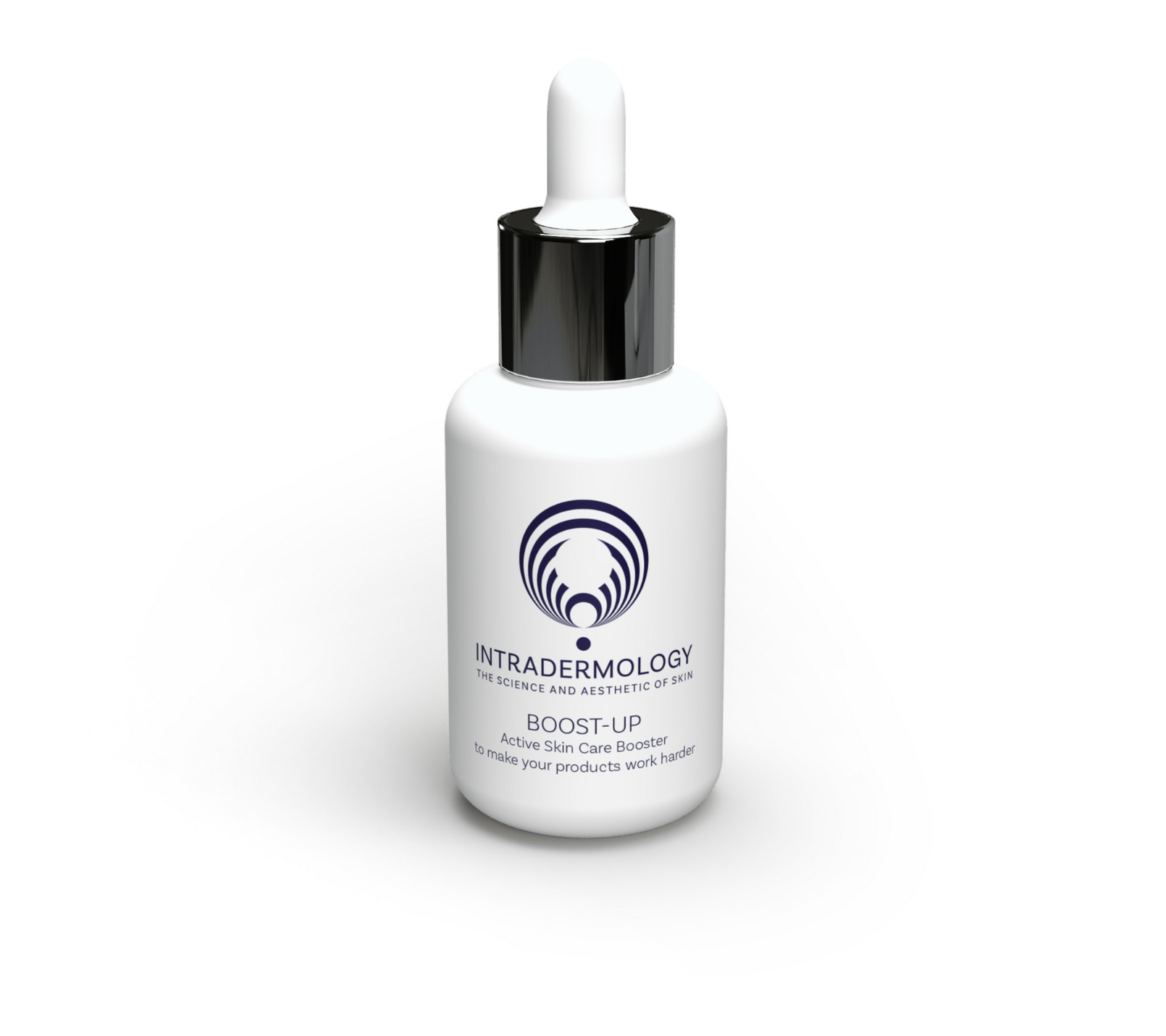
Boost-up
Ingredients overview
Highlights
Key Ingredients
Skim through
| Ingredient name | what-it-does | irr., com. | ID-Rating |
|---|---|---|---|
| Triheptanoin | emollient | ||
| Camellia Japonica Seed Oil | emollient | ||
| Squalane | skin-identical ingredient, emollient | 0, 1 | goodie |
| Dicaprylyl Ether | emollient, solvent | ||
| Ascorbyl Tetraisopalmitate | antioxidant | ||
| Caprylic/Capric Triglyceride | emollient | ||
| Astrocaryum Murumuru Seed Butter | emollient | ||
| Gossypium Herbaceum Seed Oil | 2, 3 | ||
| Bidens Pilosa Extract | moisturizer/humectant | ||
| Linum Usitatissimum Seed Oil | emollient, perfuming | goodie | |
| Hydroxymethoxyphenyl Decanone | antioxidant, soothing | goodie | |
| Dimethylmethoxy Chromanol | antioxidant | goodie | |
| Tocopherol | antioxidant | 0-3, 0-3 | goodie |
Intradermology Boost-upIngredients explained
A light, oily liquid (triglyceride of seven carbon length fatty acid, heptanoic acid) that works as a very high spreadability and low viscosity emollient making the skin nice and smooth.

It seems to us that squalane is in fashion and there is a reason for it. Chemically speaking, it is a saturated (no double bonds) hydrocarbon (a molecule consisting only of carbon and hydrogen), meaning that it's a nice and stable oily liquid with a long shelf life.
It occurs naturally in certain fish and plant oils (e.g. olive), and in the sebum (the oily stuff our skin produces) of the human skin. As f.c. puts it in his awesome blog post, squalane's main things are "emolliency, surface occlusion, and TEWL prevention all with extreme cosmetic elegance". In other words, it's a superb moisturizer that makes your skin nice and smooth, without being heavy or greasy.
Another advantage of squalane is that it is pretty much compatible with all skin types and skin conditions. It is excellent for acne-prone skin and safe to use even if you have fungi-related skin issues, like seborrhea or fungal acne.
The unsaturated (with double bonds) and hence less stable version of Squalane is Squalene, you can read about it here >>
A clear, colorless and odorless oily liquid that works as a fast-spreading emollient with a dry skin feel.

A super common emollient that makes your skin feel nice and smooth. It comes from coconut oil and glycerin, it’s light-textured, clear, odorless and non-greasy. It’s a nice ingredient that just feels good on the skin, is super well tolerated by every skin type and easy to formulate with. No wonder it’s popular.



The oil coming from the plant Linum Usitatissimum or commonly called Flax. If you are into healthy eating, you probably know flaxseeds as a rich source of hard-to-eat-enough omega-3 fatty acids, or if you are into fashion, you probably have some light summer cloth made from linen.
As for skincare, flaxseed oil is one of the few natural plant oils that is a rich source (35-65%) of moisturizing and probably anti-inflammatory ω-3 fatty acid, aka linolenic acid. It also contains skin-nourishing oleic acid (11-35%) and barrier repairing linoleic acid (11-24%).
According to manufacturer claims, it is used as an emollient, anti-inflammatory and healing agent and it is well-known to create smooth and soft skin.
A nature-identical (but synthetic) molecule that copies a phyto-active found in grains of paradise, a spice from the ginger family. It is claimed to be a 4-in-1 active with potent topical & cellular antioxidant, anti-irritant, and hyaluronic acid booster activity, however, the manufacturer did only some in-vitro and ex-vivo (as in nothing done on real people... ) tests to back up these claims.
A synthetic molecule that has a similar structure to α-Tocopherol (vitamin E) and works as a super potent antioxidant. It's known for not only protecting against reactive oxygen species (ROS) but also against reactive nitrogen species (RNS) (both are evil reactive molecules that cause damage to cells and tissues and are responsible for several mechanisms which trigger skin aging).
There are different methods to evaluate the antioxidant power of an ingredient and according to the so-called TBA-assay, Dimethylmethoxy Chromanol is a more potent antioxidant than BHT, trolox or tocopherol. Its recommended dosage is only 0.01-0.05%, that also signals how potent Lipochroman-6 is.
- Primary fat-soluble antioxidant in our skin
- Significant photoprotection against UVB rays
- Vit C + Vit E work in synergy and provide great photoprotection
- Has emollient properties
- Easy to formulate, stable and relatively inexpensive
You may also want to take a look at...
| what‑it‑does | emollient |
| what‑it‑does | emollient |
| what‑it‑does | skin-identical ingredient | emollient |
| irritancy, com. | 0, 1 |
| what‑it‑does | emollient | solvent |
| what‑it‑does | antioxidant |
| what‑it‑does | emollient |
| what‑it‑does | emollient |
| irritancy, com. | 2, 3 |
| what‑it‑does | moisturizer/humectant |
| what‑it‑does | emollient | perfuming |
| what‑it‑does | antioxidant | soothing |
| what‑it‑does | antioxidant |
| what‑it‑does | antioxidant |
| irritancy, com. | 0-3, 0-3 |





